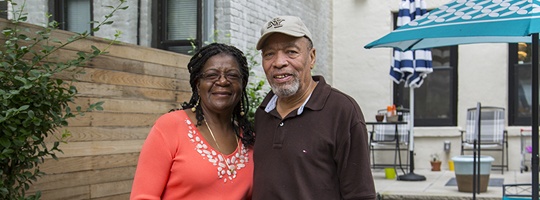When the graceful limestone building at Polhemus Place was built back in 1893, it very likely served as a brand new start for a wealthy Manhattan family. Manhattan had become increasingly congested and the opening of the Brooklyn Bridge in May of 1883 allowed the first suburban commuters to take on a new start of brand new housing with all the modern amenities. Frederick Law Olmsted and Calvert Vaux’s magnificent Prospect Park had taken shape just two blocks away, and the farmlands here were rapidly being gobbled up by Manhattanites eager for an urban respite in the bucolic neighborhood that would come to be known as Park Slope.
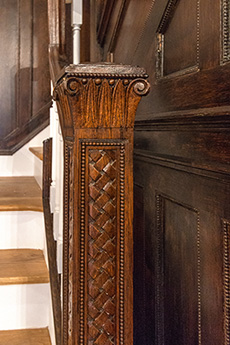
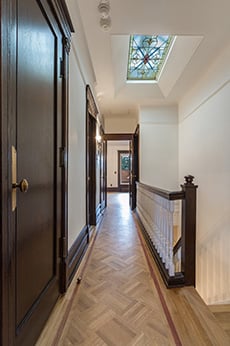
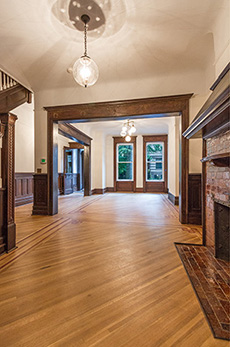
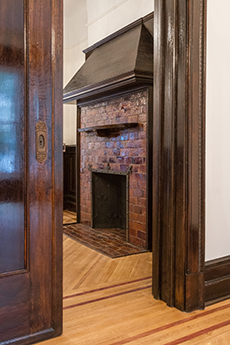
One hundred and twenty years later, when Dixon purchased the historic property in September 2013, after a century of alternating decline and revival Brooklyn was once again the most fashionable destination for moving Manhattanites. Park Slope had earned a reputation as the in-vogue borough’s most serene neighborhood, and Polhemus Place in particular, a tiny tree-lined enclave running between Carroll Street and Garfield Place, stands out as an almost unbelievably tranquil destination. With history in mind, Dixon set out to restore the Renaissance Revival property at Polhemus Place with one goal: to restore it into a magnificent single-family home, preserving as many original old-world details as possible while upgrading amenities for the most discerning twenty-first century clientele.
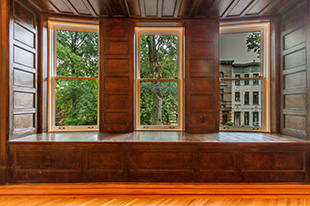
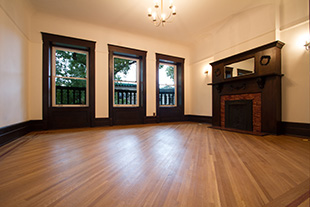
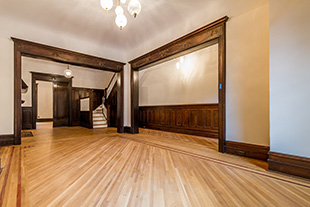
The Dixon team began by tackling the 4,524-square-foot home’s limestone façade, where a century of exposure and oxidization had taken its toll in the form of various shades of green and grey. Three days of painstakingly fine brushwork brought back the original grandeur of the exterior along with its distinctive copper details.
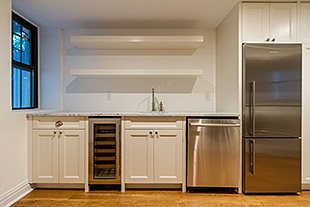
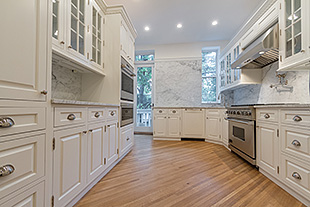
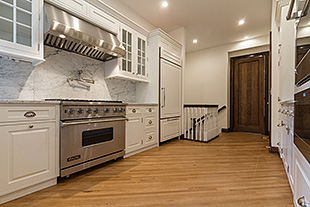
Inside, the team restored every salvageable original detail, from the ornate woodwork to the finely carved details on the wainscoting, restoring the original spirit of the townhouse while bringing a brand new 4-bedroom, 4.5-bathroom single-family home to life. When details were not salvageable, the team used neighboring homes for reference to select all-new fixtures and finishes that matched those from the home’s original period.
While many mansions from this era feature entertaining and cooking spaces on separate levels, the property was thankfully equipped with a first floor that contained the living room, dining room, and kitchen all on one level—making the layout ideal for modern tastes. The entry foyer and living room, however, were dark and gloomy spaces with minimal lighting. So Dixon hired Brooklyn-based designer Michelle James to create two elegant fixtures crafted from repurposed glass bulbs in order to illuminate the space.
The kitchen, an addition put on at some point in the twentieth century, now stood in an unenviable state, with mica cabinets and outdated fixtures. A completely new kitchen was installed, incorporating high-end custom cabinetry and stainless steel appliances, while keeping with a stately motif that matches the century-old home.
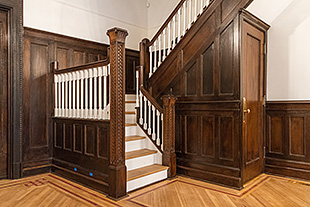
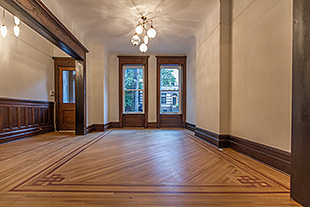
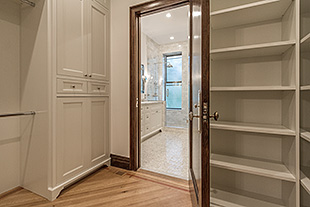
Meanwhile, a powder room to the right of the kitchen was swapped to the other side to make way for a new set of stairs leading down to a new recreation and lounge area in the English basement—an unfinished cellar filled with mechanicals and pipes before the project started. Now complete with a kitchenette, wet bar, full bathroom, and new wood floors, the basement is connected to upstairs but can function as its own living space.
Going up from the main level, the original staircases have been restored with new treads, while the original wooden railings and posts remain. Since various renovations had added different flooring throughout, new floors were installed across the home, working with inch-and-a-quarter strip wood planks that match those used in the 1890s. Similarly, all the doors in the home were mismatched, with different hardware from different eras in each one. A custom designer was brought in to redo every door in the original style.
Throughout the second and third levels, each bedroom has been restored with the goal of maintaining its unique character through preservation of original details like vaulted ceilings, pier mirror frames, a stained glass skylight, and decorative fireplaces with tiled mantles. Meanwhile, a once forgotten storage room with a few spare shelves has been transformed into a luxurious walk-in closet with custom built-ins lining its walls.
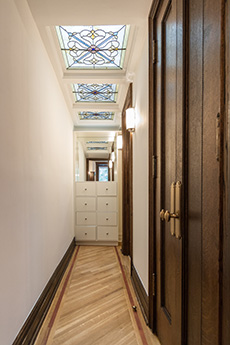
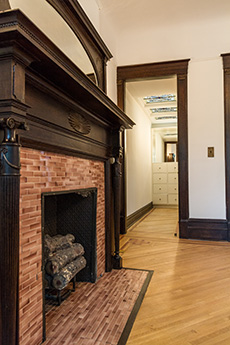

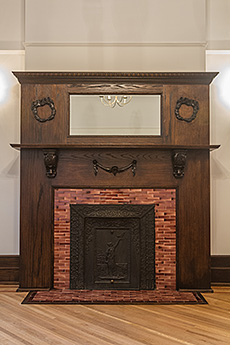
The common bathrooms that once faced each hallway have been replaced with spa-like en-suite baths, each one outfitted with a modern design that works in vintage details like a slipper clawfoot tub with modern amenities including separate glass-enclosed rain showers, marble-topped double vanities, and beautiful white Carrara tile.
On the top floor, a sunny library/home office leads out to the piece de resistance, a spacious, rear-facing roof terrace. While the 1890s residents would surely not have thought of such an elevated escape, the most recent residents used to crawl out the third-floor window onto the unfinished roof. Upping the ante on that, Dixon put in a door, built a few steps up, and rebuilt the entire roof to be able to support a finished roof deck complete with Ipe wood flooring and a view stretching to the new World Trade Center.
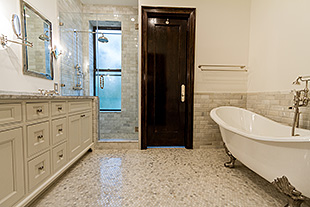
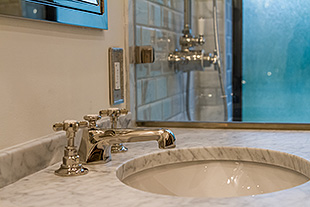
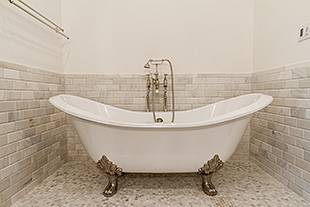
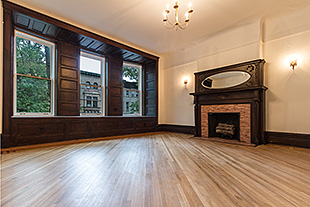
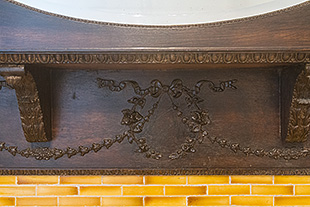
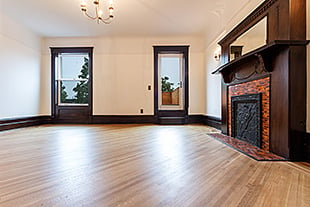
 201 366 8692
201 366 8692





